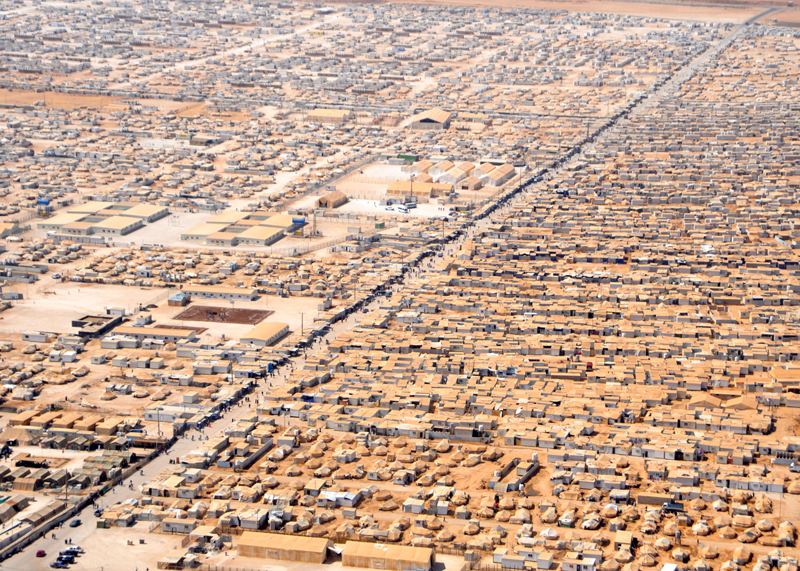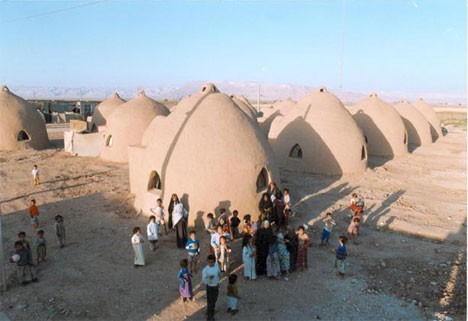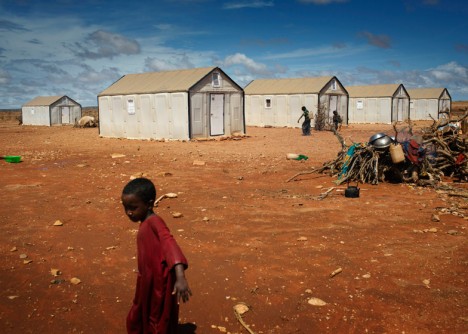[ Will refugee camps be the cities of tomorrow in the U.S. and other developed nations? As oil shortages disrupt supply chains; food shortages grow larger every year from climate change, topsoil erosion, and shortages of natural-gas fertilizer; and rising sea levels displace millions, what other choice besides refugee camps will governments have?
The alternative is mass migrations overwhelming areas that are still managing to cope, disease, starvation, militias raiding homes and ransacking them for food, and other social disorder.
Refugee camps, Hoovervilles — call them what you will — are a way to concentrate people in a small area where it is easier to provide food and other aid, and keep other areas not in crisis yet from being overwhelmed by evacuees.
There are of course, other choices. When Japan saw the U.S. was about to cut off their oil supplies, they started World War II. When North Korea stopped receiving oil and food aid, they built nuclear weapons to blackmail other nations for aid, and only a small elite lives well while millions have died and tens of millions suffer. Other ways governments have coped in the past are concentration camps and collective farms. So however dismal a refugee camp might appear to be, it sure beats the alternatives.
Although the article below is about refugees who have fled their home country, tomorrow’s refugees will be climate change and energy and natural resource shortage refugees. For example, as heat, drought, lack of water, and a lack of 24 x 7 electricity prevent air-conditioners from working, many in Arizona will flee to other states. Hurricanes and sea level rise will swamp homes, refineries, nuclear power plants, and electricity generation, sending millions in coastal states inland.
Maybe its time for local governments to plan for permanent refugee camps and have plenty of birth control pills on hand so that the misery doesn’t continue to grow at a time when everything else is shrinking.
Alice Friedemann www.energyskeptic.com author of “When Trucks Stop Running: Energy and the Future of Transportation”, 2015, Springer and “Crunch! Whole Grain Artisan Chips and Crackers”. Podcasts: KunstlerCast 253, KunstlerCast278, Peak Prosperity , XX2 report ]
Kurt Kohlstedt. 2015-12-1. Cities of Tomorrow: Refugee Camps Require Longer-Term Thinking. weburbanist
Former mayor of the world’s second-largest refugee camp, humanitarian Kilian Kleinschmidt notes “the average stay today in a camp is 17 years. That’s a generation.” These places need to be recognized as what they are: “cities of tomorrow,” not the temporary spaces we like to imagine. “In the Middle East, we were building camps: storage facilities for people. But the refugees were building a city,” Kleinschmidt said in an interview. Short-term thinking on camp infrastructure leads to perpetually poor conditions, all based on myopic optimism regarding the intended lifespan of these places.
Many refugees may never be able return home, and that reality needs to be realized and incorporated into solutions. Treating their situation as temporary or reversible puts people into a kind of existential limbo; inhabitants of these interstitial places can neither return to their normal routines nor move forward with their lives.. On the one hand, assert experts like Kleinschmidt, planners need build up refugee camps to be durable and sufficient places in their own right. On the other, they also need to move refugee migrants toward countries and regions where they will end up virtuously integrated into struggling economies, including (though controversially): areas of nearby Europe with unused housing and high labor needs.
Beyond providing more thoroughly for essentials, Kleinschmidt sees additional opportunities to enable refugees with new technologies: “With a [3D-printing] Fab Lab people could produce anything they need – a house, a car, a bicycle, generating their own energy, whatever,” he said. Unfortunately, governmental bureaucracies and aid organizations are reluctant to push boundaries and try new approaches. More fundamentally: they frequently fail to recognize the need for robust solutions that help facilitate refugees who are themselves working hard to create real places for living.
“I think we have reached the dead end almost where the humanitarian agencies cannot cope with the crisis,” he said. “We’re doing humanitarian aid as we did 70 years ago after the second world war. Nothing has changed.” Kleinschmidt worked with the United Nations and their High Commission for Refugees for 25 years before starting an independent consultancy that continues to address humanitarian issues around the globe.




9 Responses to Oil shortages and climate change may lead to refugee camps even in the U.S. and Europe